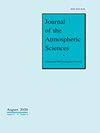Regimes of Convective Self-Aggregation in Convection-Permitting Beta-Plane Simulations
IF 2.8
3区 地球科学
Q2 METEOROLOGY & ATMOSPHERIC SCIENCES
引用次数: 0
Abstract
The spontaneous self-aggregation (SA) of convection in idealized model experiments highlights the importance of interactions between tropical convection and the surrounding environment. The authors have shown that SA fundamentally changes with the background rotation in previous f-plane simulations, both in terms of the resulting forms of organized convection, and the relative roles of the physical feedbacks driving them. This study considers the dependence of SA on rotation in one large domain on the β-plane, introducing an additional layer of complexity. Simulations are performed with uniform thermal forcing and explicit convection. Focuses include statistical and structural analysis of the convective modes, process-oriented diagnostics of how they develop, and resulting mean states. Two regimes of SA emerge within the first 15 days, separated by a critical zone where f is analogous to 10-15° latitude. Organized convection at near-equatorial values of f primarily consists of convectively-coupled Kelvin waves. Wind speed-surface enthalpy flux feedbacks are the dominant process driving moisture variability early on, then clear-sky shortwave radiative feedbacks are strongest in wave maintenance. In contrast, at higher f, numerous tropical cyclones develop and co-exist, dominated by surface flux and longwave processes. Tropical cyclogenesis is most pronounced at intermediate f (analogous to 25-40°), but are longer-lived at higher f. The resulting modes of SA at low f differ between these β-plane simulations (convectively-coupled waves) and prior f-plane simulations (weak tropical cyclones or non-rotating clusters). Otherwise, these results provide further evidence for the changing roles of radiative, surface flux, and advective processes in influencing SA as f changes, as found in our previous study.允许对流的β平面模拟中对流自聚集的状态
理想模式实验中对流的自发自聚集(SA)突出了热带对流与周围环境相互作用的重要性。作者已经表明,在之前的f平面模拟中,SA从根本上改变了背景旋转,无论是在有组织对流的结果形式方面,还是在驱动它们的物理反馈的相对作用方面。本研究考虑了在β-平面上的一个大区域内SA对旋转的依赖,引入了一个额外的复杂性层。在均匀热强迫和显对流条件下进行了模拟。重点包括对流模式的统计和结构分析,对流模式如何发展的过程导向诊断,以及由此产生的平均状态。在最初的15天内出现两种SA状态,由一个关键区域隔开,其中f类似于10-15°纬度。近赤道f值处的有组织对流主要由对流耦合开尔文波组成。风速-地表焓通量反馈是早期驱动水汽变率的主要过程,然后晴空短波辐射反馈在波浪维持中最强。相反,在较高的f,以地表通量和长波过程为主,许多热带气旋发展和共存。热带气旋形成在中间f(类似于25-40°)最明显,但在较高f时寿命更长。在低f处得到的SA模式不同于这些β平面模拟(对流耦合波)和先前的f平面模拟(弱热带气旋或非旋转簇)。此外,这些结果进一步证明了辐射通量、地表通量和平流过程在影响SA变化中的作用,正如我们之前的研究所发现的那样。
本文章由计算机程序翻译,如有差异,请以英文原文为准。
求助全文
约1分钟内获得全文
求助全文
来源期刊

Journal of the Atmospheric Sciences
地学-气象与大气科学
CiteScore
0.20
自引率
22.60%
发文量
196
审稿时长
3-6 weeks
期刊介绍:
The Journal of the Atmospheric Sciences (JAS) publishes basic research related to the physics, dynamics, and chemistry of the atmosphere of Earth and other planets, with emphasis on the quantitative and deductive aspects of the subject.
The links provide detailed information for readers, authors, reviewers, and those who wish to submit a manuscript for consideration.
 求助内容:
求助内容: 应助结果提醒方式:
应助结果提醒方式:


